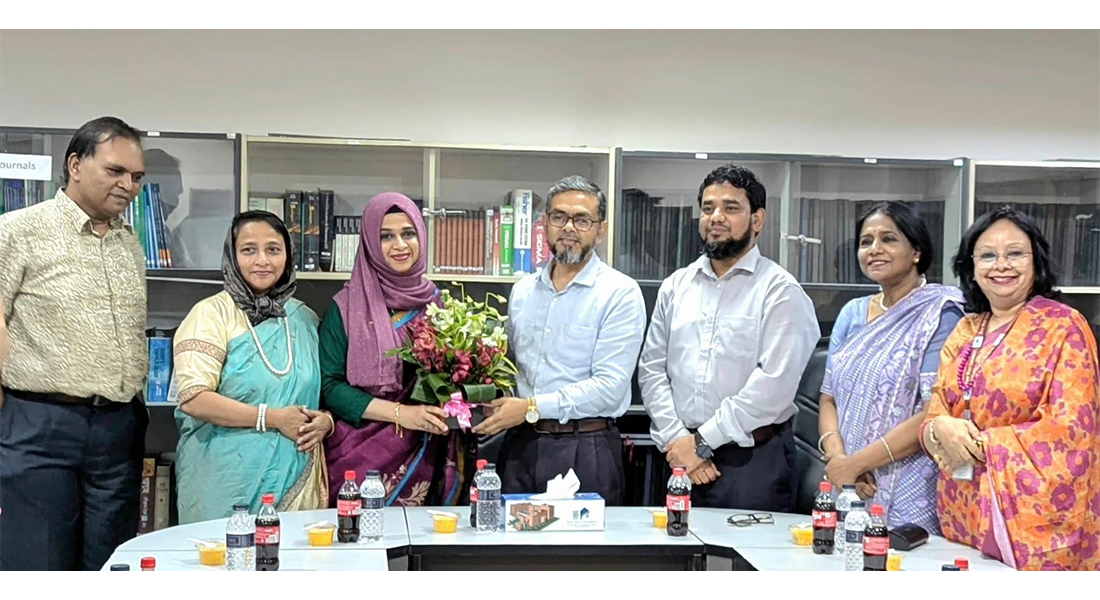

East West University (EWU) is growing steadily upholding the sprits of its oath “Excellence in Education” in order to contribute to the development of the business and technological sectors of Bangladesh. Our programs are updated continuously by an independent academic council consisting of scholars from renowned academic institutions of the country and are based on curricula North American Universities. Our graduates are much sought after and employed by the corporate sectors of the country.



The Department of Pharmacy, East West University, organized an insightful seminar titled “Unveiling Molecular Structure ...

The Department of Pharmacy of East West University is honored to announce that Dr. Rejina Afrin, Associate Professor, as...

On 25 September 2025, the Department of Pharmacy at East West University organized a vibrant day-long program to celebra...

The Symposium on “Strengthening Industry–Academia Partnership in Healthcare and Materials Science” was successfully held...

A cordial program was arranged by Department of Pharmacy, East West University, on August 26, 2025 to welcome back two d...

On August 26, 2025, we, the members of Department of Pharmacy, came together not to bid farewell, but to celebrate the r...
This course has the objective to get the students well versed with some of the basic concepts of Physical Chemistry having application in pharmacy, which includes states of matter, solutions, pH, buffer and chemical kinetics. The course has been designed to offer comfort for the students in understanding some of the very cardinal areas of drug manufacturing, realizing the vast roles of numerous chemical kinetics and spelling out some of the unique mechanisms that
govern the ADME process.
Course learning outcomes:
After completing this course, the students will be able to
1. Describe the properties and laws as well as use equation to solve various mathematical problems of states of matters: solid, liquid and gas
2. Display a thorough understanding of liquid solutions and colligative properties of dilute solutions
3. Apply the knowledge of the basic concepts of acids and bases, buffer systems and chemical kinetics to calculate the pH of solutions and order of reactions
Mapping of course learning outcomes (CLOs) with program outcomes (POs):
| SI. | CLOs | POs |
|---|---|---|
| 1 | Describe the properties and laws as well as use equation to solve
various mathematical problems of states of matters: solid, liquid and gas |
PO2 & PO12 |
| 2 | Display a thorough understanding of liquid solutions and colligative
properties of dilute solutions |
PO2 & PO12 |
| 3 | Apply the knowledge of the basic concepts of acids and bases, buffer
systems and chemical kinetics to calculate the pH of solutions and order of reactions |
PO2 & PO12 |
This course deals with the molecular and cellular processes that occur for the development of human beings. The course will give an overview of the basic structure and function of cells, cellular inclusions with anatomical focus. It also deals with anatomical structures and functions of tissues, organs and body systems, steps and histological perspectives of human development.
Course learning outcomes:
At the end of the course, the student will be able to
1. Define the different terminologies related to human anatomy
2. Describe the structure and function of the different anatomical structures in the human body
3. Explain the processes of different cellular transport systems, cell divisions, and growth
Mapping of course learning outcomes (CLOs) with program outcomes (POs):
| SI. | CLOs | POs |
|---|---|---|
| 1 | Define the different terminologies related to human anatomy | PO4 |
| 2 | Describe the structure and function of the different anatomical
structures in the human body |
PO4 |
| 3 | Explain the processes of different cellular transport systems, cell
divisions and growth |
PO4 |
The course is designed to study the basic concepts of organic chemistry, atoms, and structure, properties, reactions and mechanisms of some important organic reactions to generate
compounds of pharmaceutical importance. The study is focused on aliphatic, aromatic and heterocyclic compounds. Synthesis and pharmaceutical uses of sulfa drugs, paracetamol,
aspirin, etc. will also be discussed. Course learning outcomes:
At the end of the course, the student will be able to
1. Explain the formation of different types of bonds and their properties
2. Identify, classify, organize, analyze, and draw structures of the different organic molecule
3. Describe the physicochemical properties of organic chemicals
4. Apply the basic rules of organic nomenclature to convert between structures and names
Mapping of course learning outcomes (CLOs) with program outcomes (POs):
| SI. | CLOs | POs |
|---|---|---|
| 1 | Explain the formation of different types of bonds and their properties | PO9 |
| 2 | Identify, classify, organize, analyze, and draw structures of different
organic molecule |
PO9, PO10 &
PO12 |
| 3 | Describe the physicochemical properties of organic chemicals | PO9 & PO12 |
| 4 | Apply the basic rules of organic nomenclature to convert between
structures and names |
PO9 & PO10 |